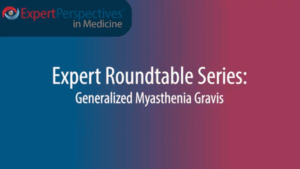Neurology
Generalized Myasthenia Gravis
The Patient Burden of Generalized Myasthenia Gravis
The problem with gMG is that it is typically silent and hidden unless a patient has obvious eyelid drooping or a disconjugate gaze. This hiddenness often makes it very frustrating for patients with MG to interact with society and their family. Many patients say that their family does not understand what is going on with them and cannot tell that they do not have the energy to cook, clean, or do yardwork, for example. So, while we understand gMG from a clinical perspective, the humanistic impact is not always appreciated by family, employers, or society.
<br>
Discussions with patients can help uncover the burden of gMG, yet sometimes they are reluctant to open up and talk about its impact on their interpersonal relationships and work. I think that this comes only after one establishes a relationship with the patient. I tell my trainees that you need to know something about each patient that has nothing to do with their disease. What are their hobbies, likes, and dislikes? Do they have children or grandchildren? If you talk about these things with a patient every time you see them, it helps them to open up.
<br>
Treatment burden is predominantly from AEs. When cholinesterase inhibitors first became available, which was followed by ACTH and prednisone, all we cared about was helping patients get out of bed and out of the house, but we could not do anything about the AEs. As therapy has evolved, we now want patients to be symptom free while experiencing minimal to no side effects. The next hurdle will be developing therapies that allow patients to be symptom free with no side effects and to have a durable response without the need for daily treatment.
<br>
Surveys of patients with gMG have found that most individuals are concerned about adverse effects from their treatment, particularly corticosteroids, and many are not happy with their treatment response. Additionally, some patients have reported being kept on a therapy despite their MG not getting better. I do not think that people are dissecting the true impact of a therapy on the disease course. It may also be that they are on too low a dose or that they are not taking the drug even though they claim to be taking it.
<br>
Another treatment burden is its logistics, as we have to send patients to a facility to receive plasma exchange, which requires time, effort, and expense. I also send patients to receive intravenous infusions for other therapies, but those living in the United States can also receive them in their own homes.
<br>
There are support groups for patients with gMG that are available to help show them that they are not alone. In the United States, the Myasthenia Gravis Foundation of America (https://myasthenia.org) and the Myasthenia Gravis Association (https://www.mgakc.org) are very active and helpful, particularly with respect to educational material, which we use all the time.
Dewilde S, Phillips G, Paci S, De Ruyck F, Tollenaar NH, Janssen MF. The burden patients with myasthenia gravis experience in terms of breathing, fatigue, sleep, mental health, discomfort and usual activities in comparison to the general population. Adv Ther. 2024;41(1):271-291. doi:10.1007/s12325-023-02704-w
<br>
Gelinas D, Parvin-Nejad S, Phillips G, et al. The humanistic burden of myasthenia gravis: a systematic literature review. J Neurol Sci. 2022;437:120268. doi:10.1016/j.jns.2022.120268
<br>
Gianatasio C, Howard J, Greene E, Sylvestri N, Dorr R, Moss B. The patient experience in myasthenia gravis: a survey of 109 individuals regarding their care journey [poster M257]. Poster presented at: 2024 Muscular Dystrophy Association Clinical & Scientific Conference; March 3-6, 2024; Orlando, FL.
<br>
Jackson K, Parthan A, Lauher-Charest M, Broderick L, Law N, Barnett C. Understanding the symptom burden and impact of myasthenia gravis from the patient’s perspective: a qualitative study. Neurol Ther. 2023;12(1):107-128. doi:10.1007/s40120-022-00408-x
<br>
Law N, Davio K, Blunck M, Lobban D, Seddik K. The lived experience of myasthenia gravis: a patient-led analysis. Neurol Ther. 2021;10(2):1103-1125. doi:10.1007/s40120-021-00285-w
<br>
Ruzhansky K, Goyal N, Muley S, Vu T. Treatment burden according to patients with generalized myasthenia gravis. Neurology. 2022;98(suppl 18). doi:10.1212/WNL.98.18_supplement.952











